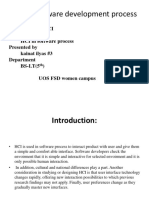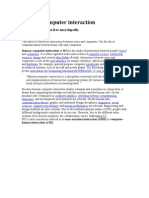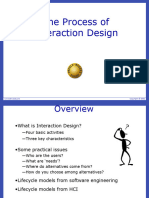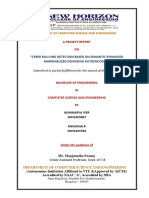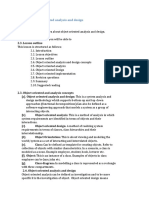HCI Process and Methodology: Human-Computer Interaction
Uploaded by
GoffiHCI Process and Methodology: Human-Computer Interaction
Uploaded by
GoffiVirtual University
Human-Computer Interaction
Lecture 16
HCI Process and Methodology
Imran Hussain
University of Management and Technology (UMT)
1 Virtual University - Human Computer Interaction © Imran Hussain | UMT
Distinctions Between HCI andSoftware
Engineering
The fundamental difference between HCI
engineering and software engineering is that
they have separate problem domains. HCI
engineering focuses on the tasks of people
using the system or product, on the information
and interactions that the users need to perform
their tasks, on the environment in which they
work.
2 Virtual University - Human Computer Interaction © Imran Hussain | UMT
Distinctions Between HCI and Software
Engineering
Software engineering focuses on the software
capabilities needed for the system to perform its
functions, accomplish its objectives, meet its
requirements. Some of the software capabilities
are also needed to support the users in
performing their tasks and interacting with the
system. Their disparate problem domains give
these disciplines separate roles and
responsibilities in the process of specifying,
designing and developing the system or product.
3 Virtual University - Human Computer Interaction © Imran Hussain | UMT
Distinctions Between HCI and Software
Engineering
4 Virtual University - Human Computer Interaction © Imran Hussain | UMT
Correlation of HCI and software engineering
• The HCI and software engineering processes closely
cooperate during the design and implementation of
interactive systems and products. Figure 2 illustrates
the interactions and information exchanges between
the processes as they relate to HCI development
5 Virtual University - Human Computer Interaction © Imran Hussain | UMT
Correlation of HCI and software engineering
6 Virtual University - Human Computer Interaction © Imran Hussain | UMT
HCI in the Software Process
• Software engineering and the design process for interactive
systems
• Usability engineering
• Iterative design and prototyping
• Design rationale
7 Virtual University - Human Computer Interaction © Imran Hussain | UMT
The Software Lifecycle
• Software engineering is the discipline for understanding the
software design process, or life cycle
• Designing for usability occurs at all stages of the life cycle, not as a
single isolated activity
8 Virtual University - Human Computer Interaction © Imran Hussain | UMT
The Life Cycle for Interactive Systems
Requirements
cannot assume a linear
specification sequence of activities
as in the waterfall model
Architectural
design
Detailed
design
Coding and
unit testing
Integration
lots of feedback! and testing
Operation and
maintenance
9 Virtual University - Human Computer Interaction © Imran Hussain | UMT
A Simple Interaction Design Model
Identify needs/
establish
requirements
(Re)Design
Evaluate
Build an
interactive
version
Final product
Exemplifies a user-centered design approach
10 Virtual University - Human Computer Interaction © Imran Hussain | UMT
The Star Lifecycle Model
• Suggested by Hartson and Hix (1989)
• Important features:
— Evaluation at the centre of activities
— No particular ordering of activities. Development may start in any one
— Derived from empirical studies of interface designers
11 Virtual University - Human Computer Interaction © Imran Hussain | UMT
The Star Model (Hartson and Hix, 1989)
task/functional
Implementation
analysis
Requirements
Prototyping Evaluation specification
Conceptual/
formal design
12 Virtual University - Human Computer Interaction © Imran Hussain | UMT
Usability Engineering Lifecycle Model
• Reported by Deborah Mayhew
• Important features:
– Holistic view of usability engineering
– Provides links to software engineering approaches, e.g. OOSE
– Stages of identifying requirements, designing, evaluating, prototyping
– Can be scaled down for small projects
– Uses a style guide to capture a set of usability goals
13 Virtual University - Human Computer Interaction © Imran Hussain | UMT
Other Process Models
• The Unified Process
– A widely-adopted process model in industry
– Originally developed by Rational (now part of IBM)
– More complicated model that what we’ve seen
– Try looking for books on this with Google or at Amazon
• Many light-weight or Agile Process Models
– Best known example: Extreme Programming
http://www.extremeprogramming.org
– Look at the diagram. Compare to waterfall and spiral
14 Virtual University - Human Computer Interaction © Imran Hussain | UMT
Agile Process Models
• Many developers and organization feel existing process models
have been too “heavy weight”
– Too many rules and documents. Inflexible. Not fun.
• XP and many other agile methods try to be alternatives
• XP says it’s: “a deliberate and disciplined approach to software
development.” (So it is a process model.)
– Claims to be good for risky projects with dynamic requirements, and when
continuous customer involvement is crucial (and possible)
– Emphasizes
• Team development: pair-programming
• Write tests before code (unit testing)
15 Virtual University - Human Computer Interaction © Imran Hussain | UMT
Final Thoughts on Process Models
• Every organization does have a process
– Might be chaos every time
– But, should be defined, documented, planned and managed
– Should be based on the nature of the projects the team is building
• People have strong feelings on this subject about what works!
16 Virtual University - Human Computer Interaction © Imran Hussain | UMT
And here endeth today’s lesson
17 Virtual University - Human Computer Interaction © Imran Hussain | UMT
You might also like
- Human-Computer Interaction: HCI PROCESS AND MethodologiesNo ratings yetHuman-Computer Interaction: HCI PROCESS AND Methodologies32 pages
- Human Computer Interaction - CS408 Power Point Slides Lecture 12100% (1)Human Computer Interaction - CS408 Power Point Slides Lecture 1250 pages
- The Design Process: Prepared by MDM PytanNo ratings yetThe Design Process: Prepared by MDM Pytan131 pages
- Presentation To CS577a University of Southern California Dr. Barry BoehmNo ratings yetPresentation To CS577a University of Southern California Dr. Barry Boehm48 pages
- Human Computer Interaction PresentationNo ratings yetHuman Computer Interaction Presentation10 pages
- 2017-Susanna Aromaa-Virtual Prototyping in Design Reviews of Industrial SystemsNo ratings yet2017-Susanna Aromaa-Virtual Prototyping in Design Reviews of Industrial Systems10 pages
- SWOT Analysis of Software Development Process ModeNo ratings yetSWOT Analysis of Software Development Process Mode10 pages
- User-Centred Design: Human Computer InteractionNo ratings yetUser-Centred Design: Human Computer Interaction11 pages
- Usabilitv Engineering Life Cycle: UsabilityNo ratings yetUsabilitv Engineering Life Cycle: Usability11 pages
- Basics of Human-Computer Interaction: 1. What Is HCI?No ratings yetBasics of Human-Computer Interaction: 1. What Is HCI?42 pages
- Human-Computer Interaction: From Wikipedia, The Free EncyclopediaNo ratings yetHuman-Computer Interaction: From Wikipedia, The Free Encyclopedia14 pages
- Using Computers in Engineering CalculationsNo ratings yetUsing Computers in Engineering Calculations3 pages
- HCI Lesson 7 - Process of Interaction DesignNo ratings yetHCI Lesson 7 - Process of Interaction Design25 pages
- Human-Computer Interaction: Mart Laanpere Tallinn University of Educational and Social SciencesNo ratings yetHuman-Computer Interaction: Mart Laanpere Tallinn University of Educational and Social Sciences17 pages
- A Closer Look On The User Centred DesignNo ratings yetA Closer Look On The User Centred Design9 pages
- Fundamental Usability Guidelines For User Interface Design: June 2008No ratings yetFundamental Usability Guidelines For User Interface Design: June 20089 pages
- User Interface Design Evaluationof Mobile ApplicationsNo ratings yetUser Interface Design Evaluationof Mobile Applications10 pages
- Design of Mechanical Equipment: Master of Technology inNo ratings yetDesign of Mechanical Equipment: Master of Technology in18 pages
- List The Principles of A Software Design in HCINo ratings yetList The Principles of A Software Design in HCI11 pages
- User Interface Design Evaluationof Mobile ApplicationsNo ratings yetUser Interface Design Evaluationof Mobile Applications10 pages
- Basicsand Importanceof Usercenteredoruser Experience UXDesign 09102023No ratings yetBasicsand Importanceof Usercenteredoruser Experience UXDesign 091020233 pages
- Process Models: Dr. Tassawar Iqbal Department of Computer Science CUI, Wah Cantt CampusNo ratings yetProcess Models: Dr. Tassawar Iqbal Department of Computer Science CUI, Wah Cantt Campus15 pages
- HCI Knowledge in Software Engineering Practices For Designing Interactive Maintenance Assistance SystemsNo ratings yetHCI Knowledge in Software Engineering Practices For Designing Interactive Maintenance Assistance Systems2 pages
- Proposal of Intelligent Medical AssistantNo ratings yetProposal of Intelligent Medical Assistant7 pages
- T No. Division of Experiment Description of ExperimentsNo ratings yetT No. Division of Experiment Description of Experiments1 page
- Microsoft: The Superior College, Ravi Campus, Shahdara, LahoreNo ratings yetMicrosoft: The Superior College, Ravi Campus, Shahdara, Lahore19 pages
- Blog Hub With Content Management System: Superior University Ravi Campus LahoreNo ratings yetBlog Hub With Content Management System: Superior University Ravi Campus Lahore17 pages
- Name: Roll No: Submitted To: Ma'am Shahista Deen Class: Bs (CS) Semester: 4 Subject: Distributed Database Project: FinalNo ratings yetName: Roll No: Submitted To: Ma'am Shahista Deen Class: Bs (CS) Semester: 4 Subject: Distributed Database Project: Final9 pages
- COS 318: Operating Systems Processes and ThreadsNo ratings yetCOS 318: Operating Systems Processes and Threads69 pages
- Web-ADI Template Settings For Microsoft ExcelNo ratings yetWeb-ADI Template Settings For Microsoft Excel14 pages
- Implementing A Host Concurrent Request APPENDIX 3: Sample Host Program (UNIX)No ratings yetImplementing A Host Concurrent Request APPENDIX 3: Sample Host Program (UNIX)4 pages
- Android Certified Application Developer - AND-401 - SampleNo ratings yetAndroid Certified Application Developer - AND-401 - Sample14 pages
- Cyberbullying Detection Based On Semantic Enhanced Marginalised Denoising Autoencoder - ReportNo ratings yetCyberbullying Detection Based On Semantic Enhanced Marginalised Denoising Autoencoder - Report71 pages
- Maulana Abul Kalam Azad University of Technology, WBNo ratings yetMaulana Abul Kalam Azad University of Technology, WB60 pages
- Software Engineering - ESC501: - Prof. Poulami DuttaNo ratings yetSoftware Engineering - ESC501: - Prof. Poulami Dutta7 pages
- Magic Cuadrant Gartner File Object Storage October2022No ratings yetMagic Cuadrant Gartner File Object Storage October202227 pages
- The A-Z of Web Scraping in 2020 (A How-To Guide)No ratings yetThe A-Z of Web Scraping in 2020 (A How-To Guide)18 pages
- Building An Online Bidding Application Using PHP50% (2)Building An Online Bidding Application Using PHP110 pages
- Lesson 2: Object Oriented Analysis and DesignNo ratings yetLesson 2: Object Oriented Analysis and Design4 pages
- Human-Computer Interaction: HCI PROCESS AND MethodologiesHuman-Computer Interaction: HCI PROCESS AND Methodologies
- Human Computer Interaction - CS408 Power Point Slides Lecture 12Human Computer Interaction - CS408 Power Point Slides Lecture 12
- Presentation To CS577a University of Southern California Dr. Barry BoehmPresentation To CS577a University of Southern California Dr. Barry Boehm
- 2017-Susanna Aromaa-Virtual Prototyping in Design Reviews of Industrial Systems2017-Susanna Aromaa-Virtual Prototyping in Design Reviews of Industrial Systems
- SWOT Analysis of Software Development Process ModeSWOT Analysis of Software Development Process Mode
- Basics of Human-Computer Interaction: 1. What Is HCI?Basics of Human-Computer Interaction: 1. What Is HCI?
- Human-Computer Interaction: From Wikipedia, The Free EncyclopediaHuman-Computer Interaction: From Wikipedia, The Free Encyclopedia
- Human-Computer Interaction: Mart Laanpere Tallinn University of Educational and Social SciencesHuman-Computer Interaction: Mart Laanpere Tallinn University of Educational and Social Sciences
- Fundamental Usability Guidelines For User Interface Design: June 2008Fundamental Usability Guidelines For User Interface Design: June 2008
- User Interface Design Evaluationof Mobile ApplicationsUser Interface Design Evaluationof Mobile Applications
- Design of Mechanical Equipment: Master of Technology inDesign of Mechanical Equipment: Master of Technology in
- User Interface Design Evaluationof Mobile ApplicationsUser Interface Design Evaluationof Mobile Applications
- Basicsand Importanceof Usercenteredoruser Experience UXDesign 09102023Basicsand Importanceof Usercenteredoruser Experience UXDesign 09102023
- Process Models: Dr. Tassawar Iqbal Department of Computer Science CUI, Wah Cantt CampusProcess Models: Dr. Tassawar Iqbal Department of Computer Science CUI, Wah Cantt Campus
- HCI Knowledge in Software Engineering Practices For Designing Interactive Maintenance Assistance SystemsHCI Knowledge in Software Engineering Practices For Designing Interactive Maintenance Assistance Systems
- Human-Machine Interface Design for Process Control ApplicationsFrom EverandHuman-Machine Interface Design for Process Control Applications
- T No. Division of Experiment Description of ExperimentsT No. Division of Experiment Description of Experiments
- Microsoft: The Superior College, Ravi Campus, Shahdara, LahoreMicrosoft: The Superior College, Ravi Campus, Shahdara, Lahore
- Blog Hub With Content Management System: Superior University Ravi Campus LahoreBlog Hub With Content Management System: Superior University Ravi Campus Lahore
- Name: Roll No: Submitted To: Ma'am Shahista Deen Class: Bs (CS) Semester: 4 Subject: Distributed Database Project: FinalName: Roll No: Submitted To: Ma'am Shahista Deen Class: Bs (CS) Semester: 4 Subject: Distributed Database Project: Final
- Implementing A Host Concurrent Request APPENDIX 3: Sample Host Program (UNIX)Implementing A Host Concurrent Request APPENDIX 3: Sample Host Program (UNIX)
- Android Certified Application Developer - AND-401 - SampleAndroid Certified Application Developer - AND-401 - Sample
- Cyberbullying Detection Based On Semantic Enhanced Marginalised Denoising Autoencoder - ReportCyberbullying Detection Based On Semantic Enhanced Marginalised Denoising Autoencoder - Report
- Maulana Abul Kalam Azad University of Technology, WBMaulana Abul Kalam Azad University of Technology, WB
- Software Engineering - ESC501: - Prof. Poulami DuttaSoftware Engineering - ESC501: - Prof. Poulami Dutta
- Magic Cuadrant Gartner File Object Storage October2022Magic Cuadrant Gartner File Object Storage October2022











